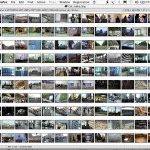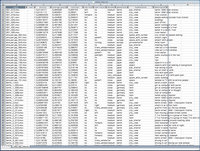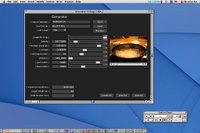On Soft Cinema: Mission to Earth

Lev Manovich describes a filmic methodology for the information age: narratives structured on the logic of databases. The delegation of a large part of the editing Mission to Earth to a computer results in a product that is "between narrative and a search engine."
Cinema and Software
The twentieth-century cinema “machine” was born at the intersection of the two key technologies of the industrial era: the engine that drives movement and the electricity that powers it. While an engine moves film inside the projector at uniform speed, the electric bulb makes possible the projection of the film image on the screen.
The use of an engine makes the cinema machine similar to an industrial factory organized around an assembly line. A factory produces identical objects that are coming from the assembly line at regular intervals. Similarly, a film projector spits out images, all the same size, all moving at the same speed. As a result, the flickering irregularity typical of the moving image toys of the nineteenth century is replaced by the standardization and uniformity typical of all industrial products.
Cinema also reflects the logic of the industrial era in another way. Ford’s assembly line, introduced in 1913, relied on the separation of the production process into a set of repetitive, sequential, simple activities. Similarly, cinema replaced previous modes of visual narration with a sequential narrative and an assembly line of shots that appear on the screen one at a time.
Given that the logic of the cinema machine was closely linked to the logic of the industrial age, what kind of cinema can we expect in the information age? Rather than waiting for this new cinema to appear, the Soft Cinema project generates new cinema forms, using the key technology of the information society - a digital computer.
As I have already explained, the logic of twentieth-century cinema was not directly connected to the operation of an engine but instead reflected the industrial logic of mass production, which the engine made possible. Similarly, the Soft Cinema project is interested not in the digital computer per se, but rather in the new structures of production and consumption enabled by computing.
Our research follows four directions:
- Following the standard convention of the human-computer interface, the display area is always divided into multiple frames.
- Using a set of rules defined by the authors, the Soft Cinema software controls both the layout of the screen (number and position of frames) and the sequences of media elements that appear in these frames.
- The media elements (video clips, sound, still images, text, etc.) are selected from a large database to construct a potentially unlimited number of different films.
- In Soft Cinema “films,” video is used as only one type of representation among others: motion graphics, 3D animations, diagrams, etc.
Together, these directions define a new aesthetic territory. The three films presented on the Soft Cinema DVD - Texas, Mission to Earth, and Absences - explore some parts of this terrain.
Mission to Earth
Inga is an alien who comes to Earth from Alpha-1, a planet that is about twenty years behind Earth culturally and technologically. Mission to Earth is an allegory of both the Cold War era and of the contemporary immigrant experience that is so frequently the norm for inhabitants of “global cities.” The film reminds us that while hybrid identity is often celebrated as progressive, it also entails psychological trauma.
One of the challenges in creating Soft Cinema films is to come up with narratives that have a structural relationship to the database aesthetics. If Texas uses semi-random database retrieval to represent “info-subjectivity,” then Mission to Earth adopts the variable choices and multi-frame layout of the Soft Cinema system to represent “variable identity.” That is, the trauma of immigration, the sense of living parallel lives, the feeling of being split between different realities. To this end, in generating every part of the film, the software chooses from among a number of alternative sequences that reflect Inga’s variable identity. Other factors, such as the choice of a large or smaller window to display a particular sequence, and the number of windows (co-present realities) that appear in a layout, simultaneously tell us what the main character is seeing and represent her thoughts, memories, and feelings.
One of the goals of this film was to visualize the narrative as much through motion graphics as through live-action video. Consequently, we invited Ross Cooper Studios to create a database of short motion-graphics clips, which would respond to the film’s narrative and to the live video footage. In most parts of the film, you will see both video clips and motion-graphics clips appearing side by side. The motion graphics react to the video, but they also hold their own. In fact, they form a parallel film that follows the same narrative but visualizes its themes and the feelings of the characters through different means.
Authoring Process in Soft Cinema: Between Narrative and a Search Engine
Each video clip in a Soft Cinema film is described by ten parameters that can specify where the video was shot, the nature of its subject matter, its average brightness and contrast, the type of space, the degree and type of camera motion, and so on. These parameters are used by the software in assembling the movies. Starting with a particular clip, the software finds other clips that are similar to it on some dimensions. This is similar to the way in which we use web search engines such as Google. When Google returns a number of results for a particular search term, we can say that all these results are connected on a few dimensions: the search term, language, domains, etc.
In Mission to Earth, while I have exercised more control over what appears on the screen in particular moments, in Texas a larger part of authoring was delegated to a computer. What you see on screen while Texas is playing are multiple sequences generated in a manner described here. Each sequence is the result of a particular search through the Soft Cinema database. Each is perhaps equivalent to a “scene” in a normal film, while a series of such searches (“scenes”) becomes equivalent to a traditional film. Film editing is thereby reinterpreted as the search through the database. Consequently, it is possible to describe a Soft Cinema film as a media object that exists “between narrative and a search engine.”
Reference
Manovich, Lev, and Andreas Kratky (2005). Soft Cinema: Navigating the Database. Cambridge, MA: MIT Press.
Cite this essay
Manovich, Lev. "On Soft Cinema: Mission to Earth" Electronic Book Review, 4 March 2008, https://electronicbookreview.com/publications/on-soft-cinema-mission-to-earth/


